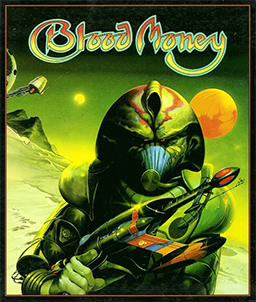The Enhanced Chip Set (ECS) is the second generation of the Amiga computer's chipset, offering minor improvements over the original chipset (OCS) design. ECS was introduced in 1990 with the launch of the Amiga 3000. Amigas produced from 1990 onwards featured a mix of OCS and ECS chips, such as later versions of the Amiga 500 and the Commodore CDTV. Other ECS models were the Amiga 500+ in 1991 and lastly the Amiga 600 in 1992.

The Original Chip Set (OCS) is a chipset used in the earliest Commodore Amiga computers and defined the Amiga's graphics and sound capabilities. It was succeeded by the slightly improved Enhanced Chip Set (ECS) and greatly improved Advanced Graphics Architecture (AGA).

Amiga demos are demos created for the Commodore Amiga home computer.

Parallax scrolling is a technique in computer graphics where background images move past the camera more slowly than foreground images, creating an illusion of depth in a 2D scene of distance. The technique grew out of the multiplane camera technique used in traditional animation since the 1930s.
Amiga Advanced Graphics Architecture (AGA) is the third-generation Amiga graphic chipset, first used in the Amiga 4000 in 1992. Before release AGA was codenamed Pandora by Commodore International.
A blitter is a circuit, sometimes as a coprocessor or a logic block on a microprocessor, dedicated to the rapid movement and modification of data within a computer's memory. A blitter can copy large quantities of data from one memory area to another relatively quickly, and in parallel with the CPU, while freeing up the CPU's more complex capabilities for other operations. A typical use for a blitter is the movement of a bitmap, such as windows and fonts in a graphical user interface or images and backgrounds in a 2D video game. The name comes from the bit blit operation of the 1973 Xerox Alto, which stands for bit-block transfer. A blit operation is more than a memory copy, because it can involve data that's not byte aligned, handling transparent pixels, and various ways of combining the source and destination data.
Bit blit is a data operation commonly used in computer graphics in which several bitmaps are combined into one using a boolean function.

The Atari Panther is a cancelled video game console from Atari Corporation that was going to be the successor to the Atari 7800 and the Atari XEGS. It was developed by the same ex-Sinclair team, Flare Technology, who were previously responsible for two cancelled console projects: the Flare One and the Konix Multisystem.
ANIM is a file format, used to store digital movies and computer generated animations, and is a variation of the ILBM format, which is a subformat of Interchange File Format.

The Television Interface Adaptor (TIA) is the custom computer chip that, along with a variant of the MOS Technology 6502, is the heart of the 1977 Atari Video Computer System game console. The TIA generates the screen display, sound effects, and reads the controllers. At the time the Atari VCS was designed, even small amounts of RAM were expensive. The chip was designed around not having a frame buffer, instead requiring detailed programming to create even a simple display.

The MOS Technology "Agnus", usually called Agnus, is an integrated circuit in the custom chipset of the Commodore Amiga computer. The Agnus, Denise and Paula chips collectively formed the OCS and ECS chipsets.

In computer graphics, a sprite is a two-dimensional bitmap that is integrated into a larger scene, most often in a 2D video game. Originally, the term sprite referred to fixed-sized objects composited together, by hardware, with a background. Use of the term has since become more general.

Hold-And-Modify, usually abbreviated as HAM, is a display mode of the Commodore Amiga computer. It uses a highly unusual technique to express the color of pixels, allowing many more colors to appear on screen than would otherwise be possible. HAM mode was commonly used to display digitized photographs or video frames, bitmap art and occasionally animation. At the time of the Amiga's launch in 1985, this near-photorealistic display was unprecedented for a home computer and it was widely used to demonstrate the Amiga's graphical capability. However, HAM has significant technical limitations which prevent it from being used as a general purpose display mode.
Graphics BASIC is a third-party extension to the Commodore BASIC V2.0 programming language of the Commodore 64 computer. It was originally written in 1983 by Ron Gilbert and Tom McFarlane. The program was licensed to Hesware, who briefly sold the program in 1984 as part of their product line before going out of business. The program was later extended by Ken Rose and Jack Thornton, and repackaged and sold in 1985 by Epyx under the title Programmers BASIC Toolkit.
A display list is a series of graphics commands that define an output image. The image is created (rendered) by executing the commands to combine various primitives. This activity is most often performed by specialized display or processing hardware partly or completely independent of the system's CPU for the purpose of freeing the CPU from the overhead of maintaining the display, and may provide output features or speed beyond the CPU's capability.

Blood Money is a side-scrolling shooter video game developed by DMA Design. It was published by Psygnosis in 1989 for the Amiga, Atari ST and MS-DOS, and in 1990 for the Commodore 64. The game is set in four different locations on a planet, where players are tasked with attacking the enemies and defeating the bosses.
The AAA chipset was intended to be the next-generation Amiga multimedia system designed by Commodore International. Initially begun as a secret project, the first design discussions were started in 1988, and after many revisions and redesigns the first silicon versions were fabricated in 1992–1993. The project was all but abandoned in 1993 after it was projected that PCs were to equal the AAA shortly after release, so a further jump was needed, leading to project Hombre. AAA was not designed to be AGA compatible.

Demo effect is computer-based real-time visual effects found in demos created by the demoscene.
Sprite multiplexing is a computer graphics technique where additional sprites can be drawn on the screen, beyond the nominal maximum. It is largely historical, applicable principally to older hardware, where limited resources meant only a relatively small number of sprites were supported. On the other hand it is also true that without multiplexing, the sprite circuitry would be idle much of the time, and limited resources were wasted.







